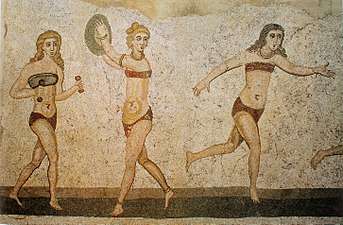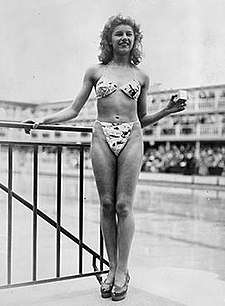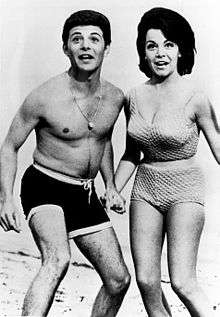Bikini

A bikini is typically a women's simple two-piece swimsuit featuring two triangles of fabric on top, similar to a bra and covering the woman's breasts, and two triangles of fabric on the bottom, the front covering the pelvis but exposing the navel, and the back covering the buttocks.[1][2] The size of the top and bottom can vary from full coverage of the breasts, pelvis, and buttocks, to very skimpy designs like a thong or G-string that cover only the areola and mons pubis, but expose the buttocks.
Fashion designer Jacques Heim from Paris released a two-piece swimsuit design in 1946 that he named the Atome. Like swimsuits of the era, it covered the wearer's navel, and it failed to attract much attention. Parisian automotive engineer and designer Louis Réard introduced his design soon after.[3] His skimpy design was risque, exposing the wearer's navel and much of her buttocks. No runway model would wear it, so he hired a nude dancer from the Casino de Paris to model it at a review of swimsuit fashions. He named the swimsuit after the Bikini Atoll, where the first public test of a nuclear bomb had taken place only four days before.[4]
Due to its controversial and revealing design, the bikini was accepted very slowly by the public. It gained increased exposure and acceptance as film stars like Brigitte Bardot, Raquel Welch, and Ursula Andress wore them and were photographed on public beaches and seen in film. In many countries the design was banned from beaches and other public places.[5]
The minimalist bikini design became common in most Western countries by the mid-1960s as both swimwear and underwear. By the late 20th century it was widely used as sportswear in beach volleyball and bodybuilding. There are a number of modern stylistic variations of the design used for marketing purposes and as industry classifications, including monokini, microkini, tankini, trikini, pubikini, and skirtini. A man's single-piece brief swimsuit may also be called a bikini.[2] Similarly, a variety of men's and women's underwear types are described as bikini underwear.
The bikini has gradually grown to gain wide acceptance in Western society. By the early 2000s, bikinis had become a US$811 million business annually, and boosted spin-off services such as bikini waxing and sun tanning.[6]
Etymology and terminology
While the two-piece swimsuit as a design existed in classical antiquity,[7] the modern design first attracted public notice in Paris on July 5, 1946.[8] French automotive engineer Louis Réard introduced a design he named the "bikini", adopting the name from the Bikini Atoll in the Pacific Ocean,[9][10] which was the colonial name the Germans gave to the atoll, transliterated from the Marshallese name for the island, Pikinni.[11]
Four days earlier, the United States had initiated its first peace-time nuclear weapons test at Bikini Atoll as part of Operation Crossroads.[12] Réard hoped his swimsuit's revealing style would create an "explosive commercial and cultural reaction" similar to the explosion at Bikini Atoll.[13][14][15][16]
By making an analogy with words like bilingual and bilateral containing the Latin prefix "bi-" (meaning "two" in Latin), the word bikini was first back-derived as consisting of two parts, [bi + kini] by Rudi Gernreich, who introduced the monokini in 1964.[17][18] Later swimsuit designs like the tankini and trikini further cemented this derivation.[19] Over time the "–kini family" (as dubbed by author William Safire[20]), including the "–ini sisters" (as dubbed by designer Anne Cole[21]), expanded into a variety of swimwear including the monokini (also known as a numokini or unikini), seekini, tankini, camikini, hikini (also hipkini), minikini, face-kini, burkini, and microkini.[22] The Language Report, compiled by lexicographer Susie Dent and published by the Oxford University Press (OUP) in 2003, considers lexicographic inventions like bandeaukini and camkini, two variants of the tankini, important to observe.[23] Although "bikini" was originally a registered trademark of Réard, it has since become genericized.[24]
Variations of the term are used to describe stylistic variations for promotional purposes and industry classifications, including monokini, microkini, tankini, trikini, pubikini, bandeaukini and skirtini. A man's brief swimsuit may also be referred to as a bikini.[2] Similarly, a variety of men's and women's underwear types are described as bikini underwear.
History
In antiquity

Archaeologist James Mellaart described the earliest bikini-like costume in Çatalhöyük, Anatolia in the Chalcolithic era (around 5600 BC), where a mother goddess is depicted astride two leopards wearing a costume somewhat like a bikini.[7][25] The two-piece swimsuit can be traced back to the Greco-Roman world, where bikini-like garments worn by women athletes are depicted on urns and paintings dating back to 1400 BC.[26]
In Coronation of the Winner, a mosaic in the floor of a Roman villa in Sicily that dates from the Diocletian period (286–305 AD), young women participate in weightlifting, discus throwing, and running ball games dressed in bikini-like garments (technically bandeaukinis in modern lexicon).[8][27] The mosaic, found in the Sicilian Villa Romana del Casale, features ten maidens who have been anachronistically dubbed the "Bikini Girls".[28][29] Other Roman archaeological finds depict the goddess Venus in a similar garment. In Pompeii, depictions of Venus wearing a bikini were discovered in the Casa della Venere,[30][31][32] in the tablinum of the House of Julia Felix,[33] and in an atrium garden of Via Dell'Abbondanza.[34]
Bikini precursors in the West
.jpg)
.jpg)
Swimming or bathing outdoors was discouraged in the Christian West, so there was little demand or need for swimming or bathing costumes until the 18th century. The bathing gown of the 18th century was a loose ankle-length full-sleeve chemise-type gown made of wool or flannel that retained coverage and modesty.[35]
In 1907, Australian swimmer and performer Annette Kellerman was arrested on a Boston beach for wearing form-fitting sleeveless one-piece knitted swimming tights that covered her from neck to toe, a costume she adopted from England,[35] although it became accepted swimsuit attire for women in parts of Europe by 1910.[36] In 1913, designer Carl Jantzen made the first functional two-piece swimwear. Inspired by the introduction of females into Olympic swimming he designed a close-fitting costume with shorts for the bottom and short sleeves for the top.[37]
During the 1920s and 1930s, people began to shift from "taking in the water" to "taking in the sun", at bathhouses and spas, and swimsuit designs shifted from functional considerations to incorporate more decorative features. Rayon was used in the 1920s in the manufacture of tight-fitting swimsuits,[38] but its durability, especially when wet, proved problematic.[39] Jersey and silk were also sometimes used.[40] By the 1930s, manufacturers had lowered necklines in the back, removed sleeves, and tightened the sides. With the development of new clothing materials, particularly latex and nylon, swimsuits gradually began hugging the body through the 1930s, with shoulder straps that could be lowered for tanning.[41]
Women's swimwear of the 1930s and 1940s incorporated increasing degrees of midriff exposure. The 1932 Hollywood film Three on a Match featured a midriff baring two piece bathing suit. Teen magazines of late 1940s and 1950s featured similar designs of midriff-baring suits and tops. However, midriff fashion was stated as only for beaches and informal events and considered indecent to be worn in public.[42] Hollywood endorsed the new glamor in films like 1949's Neptune's Daughter in which Esther Williams wore provocatively named costumes such as "Double Entendre" and "Honey Child".[43]
Wartime production during World War II required vast amounts of cotton, silk, nylon, wool, leather, and rubber. In 1942, the United States War Production Board issued Regulation L-85, cutting the use of natural fibers in clothing[44] and mandating a 10% reduction in the amount of fabric in women's beachwear.[45] To comply with the regulations, swimsuit manufacturers removed skirt panels and other attachments,[9] while increasing production of the two-piece swimsuit with bare midriffs.[46] At the same time, demand for all swimwear declined as there was not much interest in going to the beach, especially in Europe.[9]
Modern bikini

In post-World War II Europe, Western Europeans enjoyed their first war-free summer in many years. French designers sought to deliver fashions that matched the liberated mood of the people.[45] Fabric was still in short supply,[47] and in an endeavor to resurrect swimwear sales, two French designers – Jacques Heim and Louis Réard – almost simultaneously launched new two-piece swimsuit designs in 1946.[48][49] Heim launched a two-piece swimsuit design in Paris that he called the atome, after the smallest known particle of matter. He announced that it was the "world's smallest bathing suit."[50][45] Although briefer than the two-piece swimsuits of the 1930s, the bottom of Heim's new two-piece beach costume still covered the wearer's navel.[47][51][52][53]
Soon after, Louis Réard created a competing two-piece swimsuit design, which he called the bikini.[54] He noticed that women at the beach rolled up the edges of their swimsuit bottoms and tops to improve their tan.[3] He introduced his design at a swimsuit review held at the popular public pool, Piscine Molitor, four days after the first test of a nuclear weapon at the Bikini Atoll. The newspapers were full of news about it and Reard hoped for the same with his design.[55][4] Réard's bikini undercut Heim's atome in its brevity. His design consisted of a two triangles of fabric forming a bra, and two triangular pieces of fabric covering the mons pubis and the buttocks connected by string. When he was unable to find a fashion model willing to showcase his revealing design,[56] Réard hired Micheline Bernardini, a 19-year old nude dancer from the Casino de Paris.[57] He announced that his swimsuit, with a total area of 30 square inches (200 cm2) of cloth, was "smaller than the world’s smallest bathing suit.".[58][59] Réard said that "like the [atom] bomb, the bikini is small and devastating".[60] Fashion writer Diana Vreeland described the bikini as the "atom bomb of fashion".[60] Bernardini received 50,000 fan letters, many of them from men.[9][37]
Photographs of Bernardini and articles about the event were widely carried by the press. The International Herald Tribune alone ran nine stories on the event.[61] French newspaper Le Figaro wrote, "People were craving the simple pleasures of the sea and the sun. For women, wearing a bikini signaled a kind of second liberation. There was really nothing sexual about this. It was instead a celebration of freedom and a return to the joys in life."[37]
Heim's atome was more in keeping with the sense of propriety of the 1940s, but Réard's design won the public's attention.[47] Although Heim's design was the first worn on the beach and initially sold more swimsuits, it was Réard's description of the two-piece swimsuit as a bikini that stuck.[8][62] As competing designs emerged, he declared in advertisements that a swimsuit could not be a genuine bikini "unless it could be pulled through a wedding ring."[9] Modern bikinis were first made of cotton and jersey.[63]
Social resistance
Lena Lenček, The Beach: The History of Paradise on Earth, 1998[64]
Despite the garment's initial success in France, women worldwide continued to wear traditional one-piece swimsuits. When his sales stalled, Réard went back to designing and selling orthodox knickers.[65] In 1950, American swimsuit mogul Fred Cole,[37] owner of mass market swimwear firm Cole of California, told Time that he had "little but scorn for France's famed Bikinis."[66] Réard himself would later describe it as a "two-piece bathing suit which reveals everything about a girl except for her mother's maiden name."[67] Fashion magazine Modern Girl Magazine in 1957 stated that "it is hardly necessary to waste words over the so-called bikini since it is inconceivable that any girl with tact and decency would ever wear such a thing".[8][37]
In 1951, Eric Morley organized the Festival Bikini Contest, a beauty contest and swimwear advertising opportunity at that year's Festival of Britain. The press, welcoming the spectacle, referred to it as Miss World,[68][69] a name Morley registered as a trademark.[70] The winner was Kiki Håkansson of Sweden, who was crowned in a bikini. After the crowning, Håkansson was condemned by Pope Pius XII,[5][71][72] while Spain and Ireland threatened to withdraw from the pageant.[73] In 1952, bikinis were banned from the pageant and replaced by evening gowns.[74][75] As a result of the controversy, the bikini was explicitly banned from many other beauty pageants worldwide.[76][77] Although some regarded the bikini and beauty contests as bringing freedom to women, they were opposed by some feminists[5][78] as well as religious and cultural groups who objected to the degree of exposure of the female body.
The bikini was banned on the French Atlantic coastline, Spain, Italy,[5] Portugal and Australia, and was prohibited or discouraged in a number of US states.[79][80] The United States Motion Picture Production Code, also known as the Hays Code, enforced from 1934, allowed two-piece gowns but prohibited the display of navels in Hollywood films.[81] The National Legion of Decency, a Roman Catholic body guarding over American media content, also pressured Hollywood and foreign film producers to keep bikinis from being featured in Hollywood movies.[82] As late as 1959, Anne Cole, one of the United States' largest swimsuit designers, said, "It's nothing more than a G-string. It's at the razor's edge of decency."[83] The Hays Code was abandoned by the mid-1960s, and with it the prohibition of female navel exposure, as well as other restrictions.[84] The influence of the National Legion of Decency also waned by the 1960s.[85]
Rise to popularity
Increasingly common glamour shots of popular actresses and models on either side of the Atlantic played a large part in bringing the bikini into the mainstream.[1] During the 1950s, Hollywood stars such as Ava Gardner, Rita Hayworth, Lana Turner,[86][87] Elizabeth Taylor,[87] Tina Louise,[87] Marilyn Monroe,[87] Esther Williams, and Betty Grable[88] took advantage of the risqué publicity associated with the bikini by posing for photographs wearing them—pin-ups of Hayworth and Williams in costume were especially widely distributed in the United States.[37] In 1950, Elvira Pagã walked at the Rio Carnival, Brazil in a golden bikini, starting the bikini tradition of the carnival.[89]
In Europe, 17-year-old Brigitte Bardot wore scanty bikinis (by contemporary standards) in the French film Manina, la fille sans voiles ("Manina, the girl unveiled"). The promotion for the film, released in France in March 1953, drew more attention to Bardot's bikinis than to the film itself. By the time the film was released in the United States in 1958 it was re-titled Manina, the Girl in the Bikini. Bardot was also photographed wearing a bikini on the beach during the 1957 Cannes Film Festival. Working with her husband and agent Roger Vadim she garnered significant attention with photographs of her wearing a bikini on every beach in the south of France.[90]
Similar photographs were taken of Anita Ekberg and Sophia Loren, among others. According to The Guardian, Bardot's photographs in particular turned Saint-Tropez into the beachwear capital of the world,[58] with Bardot identified as the original Cannes bathing beauty.[91] Bardot's photography helped to enhance the public profile of the festival, and Cannes in turn played a crucial role in her career.[92]
Brian Hyland's novelty-song hit "Itsy Bitsy Teenie Weenie Yellow Polka Dot Bikini" became a Billboard No. 1 hit during the summer of 1960: the song tells a story about a young girl who is too shy to wear her new bikini on the beach, thinking it too risqué.[93] Playboy first featured a bikini on its cover in 1962; the Sports Illustrated Swimsuit Issue debut two years later featured Babette March in a white bikini on the cover.[94]

Ursula Andress, appearing as Honey Rider in the 1962 British James Bond film, Dr. No, wore a white bikini, which became known as the "Dr. No bikini". It became one of the most famous bikinis of all time and an iconic moment in cinematic and fashion history.[95][96][97] Andress said that she owed her career to that white bikini, remarking, "This bikini made me into a success. As a result of starring in Dr. No as the first Bond girl, I was given the freedom to take my pick of future roles and to become financially independent."[95][98]
The bikini finally caught on, and by 1963, the movie Beach Party, starring Annette Funicello and Frankie Avalon, led a wave of films that made the bikini a pop-culture symbol, though Funicello was barred from wearing Réard's bikini unlike the other young females in the films. In 1965, a woman told Time that it was "almost square" not to wear a bikini; the magazine wrote two years later that "65% of the young set had already gone over".[86]
Raquel Welch's fur bikini in One Million Years B.C. (1966) gave the world the most iconic bikini shot of all time and the poster image became an iconic moment in cinema history.[99] Her deer skin bikini in One Million Years B.C., advertised as "mankind's first bikini",[100] (1966) was later described as a "definitive look of the 1960s".[101] Her role wearing the leather bikini raised Welch to a fashion icon[8] and the photo of her in the bikini became a best-selling pinup poster.[101]
Stretch nylon bikini briefs and bras complemented the adolescent boutique fashions of the 1960s, allowing those to be minimal.[102] DuPont introduced lycra (DuPont's name for spandex) in the same decade.[38] Spandex expanded the range of novelty fabrics available to designers which meant suits could be made to fit like a second skin without heavy linings.[103] "The advent of Lycra allowed more women to wear a bikini," wrote Kelly Killoren Bensimon, a former model and author of The Bikini Book, "It didn't sag, it didn't bag, and it concealed and revealed. It wasn't so much like lingerie anymore."[104] Increased reliance on stretch fabric led to simplified construction.[1] It allowed designers to create the string bikini, and allowed Rudi Gernreich to create the topless monokini.[105] Alternative swimwear fabrics such as velvet, leather, and crocheted squares surfaced in the early '70s.[1]
Mass acceptance
Réard's company folded in 1988,[106] four years after his death.[107] By the end of the century, the bikini had become the most popular beachwear around the globe. According to French fashion historian Olivier Saillard, this was due to "the power of women, and not the power of fashion". As he explains, "The emancipation of swimwear has always been linked to the emancipation of women",[8] though one survey indicates 85% of all bikinis never touch the water.[108] By 1988 the bikini made up nearly 20% of swimsuit sales, more than any other model in the US,[83] though one-piece suits made a comeback during the 1980s and early 1990s.[107]
In 1997, Miss Maryland Jamie Fox became the first contestant in 50 years to compete in a two-piece swimsuit at the Miss America Pageant.[109] Actresses in action films like Blue Crush (2002) and Charlie's Angels: Full Throttle (2003) made the two-piece "the millennial equivalent of the power suit", according to Gina Bellafonte of The New York Times,[37]
According to Beth Dincuff Charleston, research associate at the Costume Institute of the Metropolitan Museum of Art, "The bikini represents a social leap involving body consciousness, moral concerns, and sexual attitudes."[37] By the early 2000s, bikinis had become a $811 million business annually, according to the NPD Group, a consumer and retail information company,[105] and had boosted spin-off services like bikini waxing and the sun tanning industries.[6]
Although child-sized bikinis appeared in the 1950s, in many European countries, swimsuits below size 11 are commonly not sold with a separate top, but in the United States, Britain, and Canada, it has often been considered unacceptable for girls in late childhood (ages 7–11) to go topless. Several incidents of families being evicted from public pools due to their child being topless have been reported.[110] In 2002, clothing retailer Abercrombie & Fitch came under criticism for selling child-sized thong bikinis and underwear.[111]
Outside the Western world


The 1967 film An Evening in Paris is mostly remembered because it featured Bollywood actress Sharmila Tagore as the first Indian actress to wear a bikini on film.[112][113] She also posed in a bikini for the glossy Filmfare magazine.[114][115] The costume shocked a conservative Indian audience,[116] but it also set in motion a trend carried forward by Zeenat Aman in Heera Panna (1973) and Qurbani (1980),[117] Dimple Kapadia in Bobby (1973),[117] and Parveen Babi in Yeh Nazdeekiyan (1982).[117][118]
Indian women wear bikinis when they vacation abroad or in Goa without the family. Despite the conservative ideas prevalent in India, bikinis have become more popular. In summer, when women take up swimming, often in a public space, a lot of tankinis, shorts and single-piece swimsuits are sold.[119] The maximum sales for bikinis happen in the winter, the honeymoon season.[119]
By the end of the first decade of the 21st century, the Chinese bikini industry became a serious international threat for the Brazilian bikini industry.[120] Huludao, Liaoning, China set the world record for the largest bikini parade in 2012, with 1,085 participants and a photo shoot involving 3,090 women.[121][122]
For most parts of the Middle East, bikinis are either banned or is highly controversial. In 1966, In 1973, when Lebanese magazine Ash-Shabaka printed a bikini-clad woman on the cover they had to make a second version with only the face of the model.[123] In 2011, Huda Naccache (Miss Earth 2011), when she posed for the cover of Lilac (based in Israel) became the first bikini-clad Arab model on the cover of an Arabic magazine.[124][125][126]
Bikini variants

While the name "bikini" was at first applied only to beachwear that revealed the wearer's navel, today the fashion industry considers any two-piece swimsuit a bikini.[127] Modern bikini fashions are characterized by a simple, brief design: two triangles of fabric that form a bra and cover the woman's breasts and a third that forms a panty cut below the navel that covers the groin and the buttocks.[1]
Bikinis can and have been made out of almost every possible clothing material, and the fabrics and other materials used to make bikinis are an essential element of their design.[128] Modern bikinis were first made of cotton and jersey. DuPont's introduction of Lycra (spandex) in the 1960s completely changed how bikinis were designed and worn, as according to Kelly Killoren Bensimon, a former model and author of The Bikini Book, "the advent of Lycra allowed more women to wear a bikini...it didn't sag, it didn't bag, and it concealed and revealed. It wasn't so much like lingerie anymore."[104] Alternative swimwear fabrics such as velvet, leather, and crocheted squares surfaced in the early 1970s.[1]
In a single fashion show in 1985, there were two-piece suits with cropped tank tops instead of the usual skimpy bandeaux, suits that resembled bikinis from the front and one-pieces from the back, suspender straps, ruffles, and deep navel-baring cutouts.[129] Metal and stone jewelery pieces are now often used to dress up look and style according to tastes. To meet the fast pace of demands, some manufacturers now offer made-to-order bikinis ready in as few as seven minutes.[130] The world's most expensive bikini was designed in February 2006 by Susan Rosen; containing 150 carats (30 g) of diamond, it was valued at £20 million.[108]
Major styles
There is a range of distinct bikini styles available — string bikinis, monokinis (topless or top and bottom connected), Trikinis (three pieces instead of two), tankinis (tank top, bikini bottom), camikinis (camisole top, bikini bottom), bandeaukini (bandeau top, bikini bottom), skirtini (bikini top, skirt bottom), "granny bikini" (bikini top, boy shorts bottom), hikinis (also hipkini), seekinis (transparent), minikinis, microkinis, miniminis, slingshots (or suspender bikinis), thong bottoms, tie-sides (a variety of string bikini) and teardrops.[22]
| Variant | Image | Year | Description |
|---|---|---|---|
| Bandeaukini | .jpg) | A bandeaukini (alternatively called a bandini)[131] is a bandeau top (no straps going over the shoulders) worn with any bikini bottom.[132][133] It is the oldest form of bikini, with earliest examples found in Sicilian Villa Romana del Casale (dubbed the "Bikini Girls) dating back to the 4th century AD.[28][29][134][135] Reintroduced, its appeal grew fast among young women,[136] with bandeau tops edging into the sales of the classic tankini.[137] | |
| Microkini |  | 1995 | A microkini, including subgenres like minikini, minimini and tear-drop, is an extremely meager bikini.[138] The designs for both women and men typically use only enough fabric to cover the genitals and, for women, the nipples. Any additional straps are merely to keep the garment attached to the wearer's body. Some variations of the microkini use adhesive or wire to hold the fabric in place over the genitals. Microkinis keep the wearer just within legal limits of decency and fill a niche between nudism and conservative swimwear.[139] |
| Monokini |  | 1964 | A monokini (also called topless swimsuit, unikini or numokini) is a women's one-piece garment equivalent to the lower half of a bikini.[140] Originally a specific design conceived by Rudi Gernreich in 1964, the term is now used to describe any topless swimsuit,[141] particularly a bikini bottom worn without a top.[142] An extreme version of the monokini, the thong-style pubikini (which exposed the pubic region), was also designed by Rudi Gernreich in 1985.[143][144] |
| Skirtini |  | The skirtini, which features a bikini top and a small, skirted bottom, is also an innovation for bikini-style clothes with more coverage.[145] Two-piece swimsuits with skirt panels were popular in the US before the government ordered a 10% reduction in fabric used in woman's swimwear in 1943 as wartime rationing.[45] In 2011, The Daily Telegraph identified the skirted bikini as one of the top 10 swimwear designs of that season.[146] | |
| Sling bikini |  | The sling bikini (also known as sling-kini, onepiecekini or sling swimsuit) is an unbroken suit, technically one-piece, which resembles a bikini bottom with the side straps extending upwards to cover the breasts and go over the shoulders, or encircling the neck while a second set of straps pass around the midriff (also known as pretzel bikini or pretzel swimsuit).[147] Sling swimsuits emerged in the early 1990s, and were introduced into the mainstream in 1994.[148][149] When designed for or worn by a man, it is called a mankini, popularized by Sacha Baron Cohen in the film Borat.[150][151] | |
| String bikini |  | 1974 | A string bikini (or a tie-side) gets its name from its design that consists of two triangular shaped pieces connected at the groin but not at the sides, where a thin "string" wraps around the waist tied together to connect the two parts. The first formal presentation of string bikini was done by Glen Tororich, a public relations agent, and his wife Brandi Perret-DuJon, a fashion model, for the opening of Le Petite Centre, a shopping area in the French Quarter of the New Orleans, Louisiana in 1974. String bikinis are one of the most popular variations of bikini.[152] |
| Tankini | _(5461706898).jpg) | 1998 | The tankini is a swimsuit combining a tank top and a bikini bottom.[132][153][154] Tankinis can be made of spandex-and-cotton or Lycra-and-nylon.[155] Designer Anne Cole, the US swimwear mogul, was the originator of this style in 1998.[132][156] A variation is named camkini, with spaghetti straps instead of tank-shaped straps over a bikini bottom.[157] |
| Trikini |  | 1967 | The trikini appeared briefly in 1967, defined as "a handkerchief and two small saucers."[158] It reappeared in the 1990s as a bikini bottom with a stringed halter of two triangular pieces covering the breasts,[159] and in the 2000s as a costume of three separate pieces.[160] The trikini top comes essentially in two separate parts.[161] The name of this woman's bathing suit is formed from the word "bikini", replacing "bi-", meaning "two", with "tri-", meaning "three".[162] In a variation the three pieces are sold as part of one continuous garment.[163] A variation is called strapless bikini[164] or a no string bikini, often a combination of two pasties with a matching maebari-style bottom.[165] |
Bikini in sport
Bikinis have become a major component of marketing various women's sports.[166] It is an official uniform for beach volleyball and is widely worn in athletics and other sports. Sports bikinis have gained popularity since the 1990s.[167] However, the trend has raised some criticism as an attempt to sell sex.[166] Female swimmers do not normally wear bikinis in competitive swimming.[168][169] The International Swimming Federation (FINA) voted to prohibit female swimmers from racing in bikinis in its meeting at Rome in 1960.[170]
Beach volleyball
_(cropped).jpg)
In 1994, the bikini became the official uniform of women's Olympic beach volleyball.[172] In 1999, the International Volleyball Federation (FIVB) standardized beach volleyball uniforms, with the bikini becoming the required uniform for women.[173] That regulation bottom is called a "bun-hugger",[174] and players names are often written on the back of the bottom.[174]
The uniform made its Olympic debut at Sydney's Bondi Beach in the 2000 Summer Olympics amid some criticism.[175] It was the fifth largest television audience of all the sports at the 2000 Games. Much of the interest was because of the sex appeal of bikini-clad players along with their athletic ability.[176] Bikini-clad dancers and cheerleaders entertain the audience during match breaks in many beach volleyball tournaments, including the Olympics.[174][177] Even indoor volleyball costumes followed suit to become smaller and tighter.[174]
However, the FIVB's mandating of the bikini ran into problems. Some sports officials consider it exploitative and impractical in colder weather.[172] It also drew the ire of some athletes.[178] At the 2006 Asian Games at Doha, Qatar, only one Muslim country – Iraq – fielded a team in the beach volleyball competition because of concerns that the uniform was inappropriate. They refused to wear bikinis.[179] The weather during the evening games in 2012 London Olympics was so cold that the players sometimes had to wear shirts and leggings.[180] Earlier in 2012, FIVB had announced it would allow shorts (maximum length 3 cm (1.2 in) above the knee) and sleeved tops at the games. Richard Baker, the federation spokesperson, said that "many of these countries have religious and cultural requirements so the uniform needed to be more flexible".[181]
The bikini remains preferred by most players[182] and corporate sponsors.[174] US women's team has cited several advantages of bikini uniforms, such as comfort while playing on sand during hot weather.[183] Competitors Natalie Cook[184] and Holly McPeak[182] support the bikini as a practical uniform for a sport played on sand during the heat of summer. Olympic gold medal winner Kerry Walsh said, "I love our uniforms." According to fellow gold medalist Misty May-Treanor and Walsh it does not restrict movement.[174]
One feminist viewpoint sees the bikini uniform as objectification of women athletes.[175] US beach volleyball player Gabrielle Reece described the bikini bottoms as uncomfortable with constant "yanking and fiddling."[174][185] Many female beach volleyball players have suffered injuries by over-straining the abdominal muscles while many others have gone through augmentation mammoplasty to look appealing in their uniforms.[175] Australian competitor Nicole Sanderson said about match break entertainment that "it's kind of disrespectful to the female players. I'm sure the male spectators love it, but I find it a little bit offensive."[186]
Sports journalism expert Kimberly Bissell conducted a study on the camera angles used during the 2004 Summer Olympic Games beach volleyball games. Bissell found that 20% of the camera angles were focused on the women's chests, and 17% on their buttocks. Bissell theorized that the appearance of the players draws fans attention more than their actual athleticism.[187][188] Sports commentator Jeanne Moos commented, "Beach volleyball has now joined go-go girl dancing as perhaps the only two professions where a bikini is the required uniform."[174][185][189] British Olympian Denise Johns argues that the regulation uniform is intended to be "sexy" and to attract attention.[190] Rubén Acosta, president of the FIVB, says that it makes the game more appealing to spectators.[175]
Bodybuilding
From the 1950s to mid-1970s, men's contest formats were often supplemented with women's beauty contests or bikini shows. The winners earned titles like Miss Body Beautiful, Miss Physical Fitness and Miss Americana, and also presented trophies to the winners of the men's contest.[191] In the 1980s, the Ms Olympia competition started in the US and in the UK the NABBA (National Amateur Body Building Association) renamed Miss Bikini International to Ms Universe. In 1986, the Ms Universe competition was divided into two sections – "physique" (for a more muscular physique) and "figure" (traditional feminine presentation in high heels).[192] In November 2010 the IFBBF (International Federation of BodyBuilding & Fitness) introduced a women's bikini contest for women who do not wish to build their muscles to figure competition levels.[193]
Costumes are regulation "posing trunks" (bikini briefs) for both men and women.[194] Female bodybuilders in America are prohibited from wearing thongs or T-back swimsuits in contests filmed for television, though they are allowed to do so by certain fitness organizations in closed events.[191] For men, the dress code specifies "swim trunks only (no shorts, cut-off pants, or Speedos)."
Other sports
.jpg)
Women in athletics often wear bikinis of similar size as those worn in beach volleyball. Amy Acuff, a US high-jumper, wore a black leather bikini instead of a track suit at the 2000 Summer Olympics.[195] Runner Florence Griffith-Joyner mixed bikini bottoms with one-legged tights at the 1988 Summer Olympics, earning her more attention than her record breaking performance in the women's 200 meters event.[196] In the 2007 South Pacific Games, the rules were adjusted to allow players to wear less revealing shorts and cropped sports tops instead of bikinis.[197] At the West Asian Games in 2006, organizers banned bikini-bottoms for female athletes and asked them to wear long shorts.[198]
String bikinis and other revealing clothes are common in surfing, though most surfing bikinis are more robust with more coverage than sunning bikinis.[199][200] Surfing Magazine printed a pictorial of Kymberly Herrin, Playboy Playmate March 1981, surfing in a revealing bikini, and eventually started an annual bikini issue.[201] The Association of Surfing Professionals often pairs female surf meets with bikini contests, an issue that divides the female pro-surfing community into two parts.[202] It has often been more profitable to win the bikini contest than the female surfing event.[203]
Body ideals
In 1950, American swimsuit mogul Fred Cole, owner of Cole of California, told Time that bikinis were designed for "diminutive Gallic women", as because "French girls have short legs... swimsuits have to be hiked up at the sides to make their legs look longer."[37] In 1961, The New York Times reported the opinion that the bikini is permissible for people are not "too fat or too thin".[204] In the 1960s etiquette writer Emily Post decreed that "[A bikini] is for perfect figures only, and for the very young."[205] In The Bikini Book by Kelly Killoren Bensimon, swimwear designer Norma Kamali says, "Anyone with a tummy" should not wear a bikini.[205] Since then, a number of bikini designers including Malia Mills have encouraged women of all ages and body types to take up the style.[206] The 1970s saw the rise of the lean ideal of female body and figures like Cheryl Tiegs. Her figure remained in vogue in the 21st century.[207]
The fitness boom of the 1980s led to one of the biggest leaps in the evolution of the bikini. According to Mills, "The leg line became superhigh, the front was superlow, and the straps were superthin."[208] Women's magazines used terms like "Bikini Belly",[209] and workout programs were launched to develop a "bikini-worthy body".[210] The tiny "fitness-bikinis" made of lycra were launched to cater to this hardbodied ideal.[211] Movies like Blue Crush and TV reality shows like Surf Girls merged the concepts of bikini models and athletes together, further accentuating the toned body ideal.[212] Some women, motivated by yearly Spring Break festivities that mark the start of the bikini season in North America,[213] engage in eating disorders in an attempt to achieve the ideal bikini body.[212]
In 1993, Suzy Menkes, then Fashion Editor of the International Herald Tribune, suggested that women had begun to "revolt" against the "body ideal" and bikini "exposure." She wrote, "Significantly, on the beaches as on the streets, some of the youngest and prettiest women (who were once the only ones who dared to bare) seem to have decided that exposure is over."[88] Nevertheless, professional beach volleyball player Gabrielle Reece, who competes in a bikini, claims that "confidence" alone can make a bikini sexy.[205] One survey commissioned by Diet Chef, a UK home delivery service, reported by The Today Show and ridiculed by More magazine, showed that women should stop wearing bikinis by the age of 47.[214][215]
Bikini underwear
Certain types of underwear are described as bikini underwear and designed for men and women. For women, bikini or bikini-style underwear is underwear that is similar in size and form to a regular bikini. It can refer to virtually any undergarment that provides less coverage to the midriff than lingerie, panties or knickers,[216] especially suited to clothing such as crop tops. For men, bikini briefs are undergarments that are smaller and more revealing than men's classic briefs. Men's bikini briefs can be low- or high-side that are usually lower than true waist, often at hips, and usually have no access pouch or flap, legs bands at tops of thighs.[217] String bikini briefs have front and rear sections that meet in the crotch but not at the waistband, with no fabric on the side of the legs.[218]
Swimwear and underwear have similar design considerations, both being form-fitting garments. The main difference is that, unlike underwear, swimwear is open to public view.[219] The swimsuit was, and is, following underwear styles,[220] and at about the same time that attitudes towards the bikini began to change, underwear underwent a redesign towards a minimal, unboned design that emphasized comfort first.[221]
History

As the swimsuit was evolving, the underwear started to change. Between 1900 and 1940, swimsuit lengths followed the changes in underwear designs.[222] In the 1920s women started discarding the corset, while the Cadole company of Paris started developing something they called the "breast girdle".[223] During the Great Depression, panties and bras became softly constructed and were made of various elasticized yarns making underwear fit like a second skin. By 1930s underwear styles for both women and men were influenced by the new brief models of swimwear from Europe. Although the waistband was still above the navel, the leg openings of the panty brief were cut in an arc to rise from the crotch to the hip joint. The brief served as a template for most all variations of panties for the rest of the century.[224] Warner standardized the concept of Cup size in 1935. The first underwire bra was developed in 1938.[223] Beginning in the late thirties skants, a type of skanty men's briefs, were introduced, featuring very high-cut leg openings and a lower rise to the waistband.[224] Howard Hughes designed a push-up bra to be worn by Jane Russell in The Outlaw in 1943, although Russell stated in interviews that she never wore the 'contraption'. In 1950 Maidenform introduced the first official bust enhancing bra.[223]
By the 1960s, the bikini swimsuit influenced panty styles and coincided with the cut of the new lower rise jeans and pants.[224] In the seventies, with the emergence of skintight jeans, thong versions of the panty became mainstream, since the open, stringed back eliminated any tell-tale panty lines across the rear and hips. By the 1980s the design of the French-cut panty pushed the waistband back up to the natural waistline and the rise of the leg openings was nearly as high (French Cut panties come up to the waist, has a high cut leg, and usually are full in the rear[225]). As with the bra and other type of lingerie, manufacturers of the last quarter of the century marketed panty styles that were designed primarily for their sexual allure.[224] From this decade sexualization and eroticization of the male body was on the rise. The male body was celebrated through advertising campaigns for brands such as Calvin Klein, particularly by photographers Bruce Weber and Herb Ritts.[226] Male bodies and men's undergarments were commodified and packaged for mass consumption, and swimwear and sportswear were influenced by sports photography and fitness.[226] Over time, swimwear evolved from weighty wool to high-tech skin-tight garments, eventually cross-breeding with sportswear, underwear and exercise wear, resulting in the interchangeable fashions of the 1990s.[227]
Men's bikini
.jpg)
The term men's bikini is sometimes used to describe swim briefs. Men's bikinis can have high or low side panels, and string sides or tie sides. Most lack a button or flap front. Unlike swim briefs, bikinis are not designed for drag reduction and generally lack a visible waistband. Suits less than 1.5 inches wide at the hips are less common for sporting purposes and are most often worn for recreation, fashion, and sun tanning. The posing brief standard to bodybuilding competitions is an example of this style. Male punk rock musicians have performed on the stage wearing women's bikini briefs.[228] The 2000 Bollywood film Hera Pheri shows men sunbathing in bikinis, who were mistakenly believed to be women from a distance.[229]
Male bikini tops also exist and are often used as visual gags.[230] A mankini is a type of sling swimsuit worn by men. The term is inspired by the word bikini.[231] It was popularized by Sacha Baron Cohen when he donned one in the film Borat.[232]
Bikini waxing
Bikini waxing is the epilation of pubic hair beyond the bikini line by use of waxing. The bikini line delineates the part of a woman's pubic area to be covered by the bottom part of a bikini, which means any pubic hair visible beyond the boundaries of a swimsuit.[241] Visible pubic hair is widely culturally disapproved, considered to be embarrassing, and often removed.[241]
As popularity of bikinis grew, the acceptability of pubic hair diminished.[242] But, with certain styles of women's swimwear, pubic hair may become visible around the crotch area of a swimsuit.[241] With the reduction in the size of swimsuits, especially since the advent of the bikini after 1945, the practice of bikini waxing has also become popular.[241] The Brazilian style which became popular with the rise of thong bottoms.[243]
Depending on the style of bikini-bottom and the amount of skin visible outside the bikini,[243] pubic hair may be styled into several styles[233][234][235] — American waxing (removal of pubic hair from the sides, top of the thighs, and under the navel), French waxing (leaves only a vertical strip in front), Brazilian waxing (removal of all hair in the pelvic area, particularly suitable for thong bottoms).[244]
Bikini tan

The tan lines created by the wearing of a bikini while tanning are known as a bikini tan. A 1969 innovation of tan-through swimwear uses fabric which is perforated with thousands of micro holes that are nearly invisible to the naked eye, but which let enough sunlight through to produce a line-free tan.[245][246]
As bikinis leave most of the body exposed to potentially dangerous UV radiation, overexposure can cause sunburn, skin cancer, as well as other acute and chronic health effects on the skin, eyes, and immune system.[247] As a result, medical organizations recommend that bikini wearers protect themselves from UV radiation by using broad-spectrum sunscreen, which has been shown to protect against sunburn, skin cancer,[248] wrinkling and sagging skin.[249] Certain sunscreen ingredients can cause harm if they penetrate the skin over time.[250]
See also
References
- 1 2 3 4 5 6 Charleston, Beth Duncuff (October 2004). "The Bikini". Heilbrunn Timeline of Art History. New York: The Metropolitan Museum of Art. Retrieved August 15, 2013.
- 1 2 3 "Bikini". Merriam-Webster. February 13, 2014.
- 1 2 "Le Bikini souffle ses 60 bougies !". www.journaldesfemmes.com (in French). Retrieved 17 May 2018.
- 1 2 3 4 Alac, Patrik (2012). Bikini Story (first ed.). Parkstone International. p. 52. ISBN 978-1-78042-951-9.
- 1 2 Lorna Edwards, "You've still got it, babe, The Age, June 3, 2006
- 1 2 Agrawala, P.K. (1983). Goddesses in Ancient India (first ed.). Atlantic Highlands, N.J.: Humanities Press. p. 12. ISBN 0-391-02960-6.
- 1 2 3 4 5 6 Kathryn Westcott, "The Bikini: Not a brief affair", BBC News, June 5, 2006
- 1 2 3 4 5 "Bikini Introduced". A&E Television Networks. Retrieved September 17, 2008.
- ↑ Cocozza, Paula (June 10, 2006). "A little piece of history". The Guardian. UK. Archived from the original on September 27, 2008. Retrieved September 17, 2008.
- ↑ "Marshallese-English Dictionary - Place Name Index". www.trussel2.com. Retrieved July 23, 2016.
- ↑ "Anatomy of an A-Bomb Test, 1946". Life. October 31, 2012. Retrieved November 21, 2012.
In July 1946, the United States conducted two atomic tests at Bikini Atoll in the Pacific.
- ↑ "The History of the Bikini". Time. July 3, 2009. Retrieved August 20, 2013.
- ↑ "Tiny Swimsuit That Rocked the World: A History of the Bikini". Randomhistory.com. May 1, 2007. Retrieved December 3, 2011.
- ↑ Brij V. Lal; Kate Fortune (2000). The Pacific Islands: an Encyclopedia. University of Hawaii Press. p. 259. ISBN 978-0-8248-2265-1. Retrieved July 5, 2011.
- ↑ Ruth Foster (June 2007). Nonfiction Reading Comprehension: Social Studies, Grade 5. Teacher Created Resources. p. 130. ISBN 978-1-4206-8030-0. Retrieved July 5, 2011.
- ↑ Gold, David L. (2009). Studies in Etymology and Etiology. Universidad de Alicante. pp. 100–101. ISBN 84-7908-517-7.
- ↑ Alac, Patrik (2012). Bikini Story. Parkstone International. p. 68. ISBN 1-78042-951-7.
- ↑ Gurmit Singh; Ishtla Singh (2013). The History of English. Routledge. pp. 13–14. ISBN 978-1-4441-1924-4.
- ↑ William Safire, No Uncertain Terms, page 291, Simon & Schuster, 2003, ISBN 0-7432-4955-0
- ↑ Trish Donnally, ""Inis" Are In", San Francisco Chronicle, May 18, 1999
- 1 2 Blake, Barry J. (2007). Playing with Words: Humour in the English Language. Equinox. p. 59. ISBN 1-84553-330-5.
- ↑ "The Language Report: The ultimate record of what we're saying and how we're saying it Archived October 5, 2015, at the Wayback Machine.", Science News (from Article Archive), August 7, 2004
- ↑ "15 Words You Had No Idea Used To Be Brand Names | Bikini". Business Insider. Retrieved May 8, 2016.
- ↑ Lucy Goodison and Christine Morris, Ancient Goddesses: The Myths and the Evidence, page 46, University of Wisconsin Press, 1998, ISBN 978-0-299-16320-4
- ↑ James, Peter J.; Thorpe, I. J.; Thorpe, Nick (1994). Ancient Inventions. Ballantine Books. p. 279. ISBN 0-345-40102-6.
- ↑ "Villa Romana del Casale". Val di Noto. Retrieved August 29, 2013.
- 1 2 Guttmann, Allen (1991). Women's Sports: A History. Columbia University Press. p. 38. ISBN 0-231-06957-X.
- 1 2 "Villa Romana del Casale". World Heritage Sites. Archived from the original on December 23, 2008. Retrieved March 7, 2015.
- ↑ "Pompeian Households: Image Gallery". The Stoa Consortium, Center for Hellenic Studies, Harvard University. Retrieved March 7, 2015.
- ↑ "Stoa Image Gallery". The Stoa Consortium, Center for Hellenic Studies, Harvard University. Retrieved March 7, 2015.
- ↑ Penelope M. Allison. "Pompeian Households: Information concerning the rooms in Casa della Venere in Bikini". Retrieved March 7, 2015.
- ↑ Beard, Mary; Henderson, John (2001). Classical Art. Oxford University Press. p. 116. ISBN 0-19-284237-4.
- ↑ MacDougall, Elisabeth B.; Feemster, Wilhelmina Mary (1979). Ancient Roman Gardens. Dumbarton Oaks. p. 38. ISBN 0-88402-100-9.
- 1 2 Claudia B. Kidwell, Women's Bathing and Swimming Costume in the United States, Smithsonian Institution Press, City of Washington, 1968
- ↑ Liz Conor, The spectacular modern woman: feminine visibility in the 1920s, page 152, Indiana University Press, 2004, ISBN 0-253-34391-7
- 1 2 3 4 5 6 7 8 9 Hoover, Elizabeth D. (July 5, 2006). "60 Years of Bikinis". American Heritage Inc. Archived from the original on September 9, 2007. Retrieved November 13, 2007.
- 1 2 Sydelle, John. "The Swimsuit Industry". The Houston Chronicle. Retrieved August 29, 2013.
- ↑ Kadolph, Sara J. & Langford, Anna L. (2001). Textiles (9 ed.). Prentice Hall. ISBN 0-13-025443-6.
- ↑ R. Turner Wilcox, The Mode in Costume, page 424, Courier Corporation, 2008, ISBN 978-0-486-46820-4
- ↑ Bronwyn Labrum, Fiona McKergow and Stephanie Gibson, Looking Flash, page 166, Auckland University Press, 2007, ISBN 978-1-86940-397-3
- ↑ Claudia Mitchell; Jacqueline Reid-Walsh (2008). Girl Culture: Studying girl culture : a readers' guide Volume 1 of Girl Culture: An Encyclopedia. ABC-CLIO. pp. 434–435. ISBN 978-0-313-33909-7.
- ↑ Sandhu, David (August 4, 2003). "Nottingham: Bathed in nostalgia". The Telegraph. London.
- ↑ "World War II". The Price of Freedom: Americans at War. Smithsonian Institution. Retrieved August 30, 2013.
- 1 2 3 4 "Bikini introduced - Jul 05, 1946 - HISTORY.com". HISTORY.com. Retrieved 16 May 2018.
- ↑ "Bikini". Fashion Encyclopedia. Retrieved August 30, 2013.
- 1 2 3 Tim Gunn, Tim Gunn's Fashion Bible: The Fascinating History of Everything in Your Closet, page 25, Simon and Schuster, 2013, ISBN 978-1-4516-4386-2
- ↑ Patrik Alac, Bikini Story, page 31, Parkstone International, 2012, ISBN 978-1-78042-951-9
- ↑ Claudia Mitchell and Jacqueline Reid-Walsh, Girl Culture: An Encyclopedia (vol. 1), page 182, Greenwood Publishing Group, 2007, ISBN 978-0-313-08444-7
- ↑ Rod E. Keays, The Naturally Good Man, page 109, Trafford Publishing, 2012, ISBN 978-1-4669-1924-2
- ↑ James Gilbert Ryan and Leonard C. Schlup, Historical Dictionary of the 1940s, page 50, M.E. Sharpe, 2006, ISBN 978-0-7656-2107-8
- ↑ Bobby Mercer, ManVentions, page 194, Adams Media, 2011, ISBN 978-1-4405-1074-8
- ↑ Kelly Killoren Bensimon, The Bikini Book, page 18, Thames & Hudson, 2006, ISBN 978-0-500-51316-3
- ↑ Adam Sage, "Happy birthday: the 'shocking and immoral' bikini hits 60", The Times, April 16, 2006
- ↑ Wiesner, Maria (5 July 2016). "70 Jahre Bikini: Vier Dreiecke und etwas Schnur". FAZ.NET (in German). Retrieved 17 May 2018.
- ↑ Alac, Patrik (2012). Bikini Story. New York: Parkstone International. p. 72. ISBN 978-1-78042-951-9.
- ↑ Rosebush, Judson. "Michele Bernadini: The First Bikini". Bikini Science. Archived from the original on September 27, 2007. Retrieved September 19, 2007.
- 1 2 Paula Cocozza, "A little piece of history", The Guardian, June 10, 2006
- ↑ The Bikini Turns 60, 1946 to 2006: 60 Years of Bikini Bathing Beauties, Lilith E-Zine
- 1 2 Judson Rosebush, "1945–1950: The Very First Bikini". Bikini Science. Archived from the original on June 27, 2012. Retrieved November 25, 2012.
- ↑ Mitchell, Claudia A.; Reid-Walsh, Jacqueline (2008). Girl Culture an Encyclopedia. Westport, Connecticut: Greenwood Press. p. 82. ISBN 0-313-08444-0.
- ↑ Weisgall, Jonathan (1994), Operation Crossroads: The Atomic Tests at Bikini Atoll, pages 264–265, Naval Institute Press, ISBN 978-1-55750-919-2
- ↑ Valerie Steele, Encyclopedia of Clothing and Fashion, page 253, Charles Scribner's Sons, 2005, ISBN 0-684-31397-9
- ↑ Lena Lenček, The Beach: The History of Paradise on Earth, page 100, Penguin Group (USA) Incorporated, 1999, ISBN 978-0-14-027802-6
- ↑ Sage, Adam (April 16, 2006). "Happy birthday: the 'shocking and immoral' bikini hits 60". The Times. London. Retrieved August 18, 2013.
- ↑ Christine Schmidt, The Swimsuit: Fashion from Poolside to Catwalk, page 2, Bloomsbury Academic, 2012, ISBN 0-85785-123-3
- ↑ Louise Southerden, Surf's Up: The Girl's Guide to Surfing, page 14, Allen & Unwin, 2008, ISBN 978-1-74176-831-2
- ↑ Stein, Elissa; Meriwether, Lee (2006). Beauty Queen. Chronicle Books. p. 45. ISBN 0-8118-4864-7.
- ↑ Dewey, Susan (2008). Making Miss India Miss World. Syracuse University Press. p. 46. ISBN 0-8156-3176-6.
- ↑ Lovegrove, Keith (2002). Pageant: The Beauty Contest. teNeues. p. 1967. ISBN 3-8238-5569-7.
- ↑ Magnanti, Brooke (June 7, 2013). "Miss World bikini ban: why it's no victory for feminists". The Telegraph. Retrieved December 13, 2013.
- ↑ "Selvedge: The Fabric of Your Life". Selvedge Ltd. 2005: 39.
- ↑ Kevin Rawlinson, "Three Miss Worlds and one (rugby) World Cup", The Daily Telegraph, June 26, 2010
- ↑ Shin, Han (2004). Beauty with a Purpose. iUniverse. p. 193. ISBN 0-595-30926-7.
- ↑ "1950-1955: Navel Maneuvers – The Bikini Breakout". Bikini Science. Archived from the original on October 13, 2013. Retrieved December 13, 2013.
- ↑ Magnanti, Brooke (June 7, 2013). "Miss World bikini ban: why it's no victory for feminists". The Telegraph. London. Retrieved August 22, 2013.
- ↑ Marcus, Ben; Divine, Jeff (2005). Surfing USA!: An Illustrated History of the Coolest Sport of All Time. MVP Books. p. 60. ISBN 978-0-89658-690-1.
- ↑ "Why OBJECT to Beauty Pageants?". object.org.uk. Archived from the original on May 22, 2014. Retrieved May 1, 2014.
- ↑ "The History of the Bikini". Time. July 3, 2009. Retrieved August 17, 2013.
- ↑ Lena Lanček and Gideon Bosker, Making Waves: Swimsuits and the Undressing of America, page 90, Cronicle Books, 1989, ISBN 978-0-87701-398-3
- ↑ Moseley, Rachel (2005). Fashioning Film Stars: Dress, Culture, Identity. BFI. p. 136. ISBN 1-84457-067-3.
- ↑ Salamone, Frank A. (2001). Popular Culture in the Fifties. University Press of America. p. 76. ISBN 0-7618-2103-1.
- 1 2 Johnson, William Oscar (February 7, 1989). "In The Swim". Sports Illustrated. Archived from the original on October 20, 2013. Retrieved August 18, 2013.
- ↑ Jeanne Nagle, Violence in Movies, Music, and the Media, page 23, The Rosen Publishing Group, 2008, ISBN 978-1-4042-1795-9
- ↑ Keith M. Booker, Historical Dictionary of American Cinema, page 65, Scarecrow Press, 2011, ISBN 978-0-8108-7459-6
- 1 2 Turner, Julia (July 29, 2013). "A Brief History of the Bikini". Slate. Retrieved August 27, 2013.
- 1 2 3 4 "Photos: On this day–July 5, 1946–the first bikini goes on sale". New Haven Register. July 5, 2013. Archived from the original on August 23, 2013. Retrieved August 23, 2013.
- 1 2 Suzy Menkes, "Runways: Remembrance of Thongs Past", The New York Times, July 18, 1993
- ↑ Colin M. MacLachlan, A History of Modern Brazil: The Past Against the Future, page 184, Rowman & Littlefield Publishers, 1993, ISBN 978-1-4616-6547-2
- ↑ "The History of the Bikini". ELLE. April 23, 2012. Retrieved August 21, 2013.
- ↑ Cari Beauchamp & Henri Béhar, Hollywood on the Riviera: The Inside Story of the Cannes Film Festival, page 165, W. Morrow and Co., 1992, ISBN 0-688-11007-X
- ↑ Vanessa R. Schwartz, It's So French!: Hollywood, Paris, and the Making of Cosmopolitan Film Culture, page 79, University of Chicago Press, 2007, ISBN 0-226-74243-1
- ↑ Suddath, Claire (July 5, 2011). "Itsy Bitsy Teeny Weenie Yellow Polka Dot Bikini". Time. Retrieved August 15, 2013.
- ↑ Gibson, Megan (5 July 2011). "Top 10 Bikinis in Pop Culture". Time. Retrieved 17 June 2018.
- 1 2 Bennett, Will (January 13, 2011). "Former Bond girl to sell Dr No bikini". The Daily Telegraph. London. Retrieved May 16, 2011.
- ↑ Bensimon, Kelly Killoren (June 5, 2006). The Bikini Book. Thames & Hudson. ISBN 978-0-500-51316-3. Retrieved May 16, 2011.
- ↑ Lindner, Christoph (August 4, 2009). The James Bond Phenomenon: A Critical Reader. Manchester University Press. ISBN 978-0-7190-8095-1. Retrieved May 16, 2011.
- ↑ Weekes, Karen (April 5, 2007). Women know everything!: 3,241 quips, quotes, & brilliant remarks. Quirk Books. p. 419. ISBN 978-1-59474-169-2. Retrieved May 16, 2011.
- ↑ Cambridge Film Trust. (2016). One Million Years B.C. Cambridge Film Festival. Retrieved December 5, 2016.
- ↑ Filmfacts 1967 Vol. 10 No. 4. University of Southern California Division of Cinema, American Film Institute. June 15, 1967. p. 42. Retrieved November 25, 2011.
- 1 2 Mansour, David (2005). From Abba to Zoom: a pop culture encyclopedia of the late 20th century. Andrews McMeel Publishing. p. 345. ISBN 978-0-7407-5118-9. Retrieved August 28, 2012.
- ↑ Amy De La Haye, The Cutting Edge: 50 Years of British Fashion, 1947–1997, page 183, Overlook Press, 1997, ISBN 0-87951-763-8
- ↑ Valerie Steele, Encyclopedia of Clothing and Fashion, page 255, Charles Scribner's Sons, 2005, ISBN 0-684-31397-9
- 1 2 Rubin, Sylvia (July 2, 2006). "Fashion shocker of '46: the naked belly button / But the bikini wasn't a hit until Sixties". San Francisco Chronicle. Retrieved August 19, 2013.
- 1 2 Rubin, Sylvia (July 2, 2006). "Fashion shocker of '46: the naked belly button". San Francisco Chronicle. Retrieved August 28, 2013.
- ↑ Rubin, Sylvia (July 2, 2006). "Fashion shocker of '46: the naked belly button". San Francisco Chronicle. Retrieved August 28, 2013.
- 1 2 Cornwell, Rupert; John Lichfield (June 17, 2006). "Boom and Bust: The nuclear age and the bikini age". The Independent. London. Archived from the original on May 2, 2008. Retrieved September 30, 2008.
- 1 2 Jayne Dawson, "Sexy at 60", Yorkshire Evenin Post, July 25, 2006
- ↑ "Photos: On this day – July 5, 1946 – the first bikini goes on sale". New Haven Register. Archived from the original on August 23, 2013. Retrieved August 22, 2013.
- ↑ "The Social - Parents furious after topless 8-year-old girl told to cover up at public pool".
- ↑ "Abercrombie criticized for sexy undies". money.cnn.com. May 22, 2002. Retrieved September 17, 2018.
- ↑ Stuff Reporter, "Being Sharmila, all through life", The Hindu, April 3, 2006
- ↑ Lalit Mohan Joshi & Gulzar, Derek Malcolm, Bollywood, page 20, Lucky Dissanayake, 2002, ISBN 0-9537032-2-3
- ↑ B. K. Karanjia, Blundering in Wonderland, page 18, Vikas Publishing House, 1990, ISBN 0-7069-4961-7
- ↑ Sharmila Tagore, First Indian actress to wear bikini
- ↑ Various writers, Rashtriya Sahara, page 28, Sahara India Mass Communication, 2002
- 1 2 3 Ghosh, Avijit (July 2, 2006). "Bollywood's unfinished revolution". The Times of India.
- ↑ "That itsy bitsy thing". The Times of India. June 16, 2006.
- 1 2 "Are Indian girls bikini ready?", Hindustan Times (New Delhi, India), March 25, 2012
- ↑ Justin Rowlatt, "Brazil's raw materials and the Chinese bikini problem", BBC, January 8, 2011
- ↑ Largest Bikini Parade, Official Website: Guinness Book of World Records
- ↑ Largest Bikini Photo Shoot, Official Website: Guinness Book of World Records
- ↑ Noha Mellor, The Making of Arab News, page 39, Rowman & Littlefield, 2005, ISBN 978-0-7425-3819-1
- ↑ Amy Kaslow, "Arab Israeli women have been hampered by a society that has accorded Arabs and women, much less Arab women, second-class status", Fortune, September 22, 2014
- ↑ Shatha Yaish, "Itsy bitsy teen weeny Arab bikini revolution", The Australian, October 12, 2011
- ↑ Pierre Klochendler, "Arab Magazine Challenges Attitudes About Arab Women", IPSNews, May 17, 2013
- ↑ Patton, Susan Ruiz (September 11, 1997). "A Bikini Isn't The Choice Of Miss Pa. For The First Time In 77 Years, Contestants In Miss America Pageant Can Choose Their Swimwear. Heather Busin Prefers One-piece". McCalls. Retrieved August 27, 2013.
- ↑ Rosebush, Judson. "Materials". Bikini Science. Archived from the original on October 5, 2013. Retrieved August 15, 2013.
- ↑ Fashion Correspondent, "Swimsuits take some inspiration from the past", Philadelphia Inquirer, November 10, 1985
- ↑ Siobhan Morrissey, "Bikinis made in teeny-weeny time, The Palm Beach Post, page 1D, August 28, 1991
- ↑ Kelly Killoren Bensimon, The Bikini Book, Assouline, 2006, ISBN 2-84323-825-0
- 1 2 3 Becky Homan, "Tankini goes over the top", St. Louis Post-Dispatch, April 3, 1999
- ↑ Patricia Marx, "On and Off the Avenue: Itsy Bitsy Teeny Weeny", page 32, The New Yorker, August 31, 2009, Volume 85, Issues 26, New Yorker Magazine Inc.
- ↑ Whitney Friedlander, That's why they're called 'bathing' suits, Los Angeles Times, May 23, 2010
- ↑ Villa Romana del Casale, UNESCO
- ↑ "Just chillin, This season's swimsuits boast new flirty styles, retro looks", Ocala Star-Banner, June 1, 2005
- ↑ Rena Fulka, "Seasonal style", The Star (Tinley Park), June 14, 2007
- ↑ Microkini at Merriam-Webster's Open Dictionary
- ↑ Mistrík, Erich, Pseudo-Concrete Ideals Of A Good Life, Human Affairs (2/2008), Department of Social & Biological Communication, Slovenská Akadémia Vied, Slovakia
- ↑ The Concise Oxford Dictionary (2004 ed.)
- ↑ "Everything Bikini". Everything Bikini. Retrieved November 12, 2012.
- ↑ "Bikini Science". Bikini Science. Archived from the original on January 8, 2010. Retrieved November 12, 2012.
- ↑ Ellen Shultz, ed. (1986). Recent acquisitions: A Selection, 1985–1986. New York: Metropolitan Museum of Art. p. 48. ISBN 978-0-87099-478-4.
- ↑ Stewart, Elizabeth Gunther; Spencer, Paula (2002). The V book : a doctor's guide to complete vulvovaginal health (Bantam trade pbk. ed.). New York: Bantam Books. p. 104. ISBN 978-0-553-38114-6.
In 1985, designer Rudi Gernreich unveiled the "pubikini," a bathing suit meant to expose pubic hair.
- ↑ Nada Manley, "Beauty & the Beach: The perfect swimsuit is out there – honestly", The Daytona Beach News-Journal, March 17, 2005
- ↑ Justine Picardie, The Closet Thinker: bathing beauties, The Daily Telegraph, July 3, 2011
- ↑ Jenny Pate, History of the swimsuit Archived September 7, 2008, at the Wayback Machine., Article Dashboard
- ↑ Slingshot Suspender Bikinis: A History, Love to know swimsuits, Glam Publisher Network
- ↑ Fashion Correspondent, "Itsy bitsy teenie weenie ... trivia think swimsuits. If two-pieces and t-backs are all that come to mind ... think again", The Miami Herald, page 1G, July 15, 1995
- ↑ Steve Helling, "Cruising Tips from New Kids on the Block", People, May 18, 2009
- ↑ Staff, "Blackpool Council considers 'mankini' outfit ban", BBC, Aug 21, 2014
- ↑ Valerie Steele, Encyclopedia of Clothing and Fashion, page 121, Charles Scribner's Sons, 2005, ISBN 0-684-31396-0
- ↑ Alisha Davis, "It Rhymes With Bikini", Newsweek, May 4, 1998
- ↑ "Tankini". oxfordlearnersdictionaries.com. Retrieved March 14, 2013.
- ↑ Anne D'Innocenzio, "Big fish rule a bigger pond", Women's Wear Daily, January 24, 2000
- ↑ Rose Apodaca Jones, "Five decades in the swim", Women's Wear Daily, Fairchild Publications, April 23, 2001
- ↑ Kathryn Bold, "Summer Sizzle Top to Bottom", Los Angeles Times, page 1, March 21, 1996
- ↑ William Safire, No Uncertain Terms, page 291, Simon & Schuster, 2004, ISBN 0-7432-5812-6
- ↑ David L. Gold, Studies in Etymology and Etiology, page 101, Universidad de Alicante, 2009, ISBN 9788479085179
- ↑ Associated Press, "Free and easy", The Age (Australia), 2004 -06-29
- ↑ John Ayto, Ian Crofton & Ebenezer Cobham Brewer, Brewer's Dictionary of Modern Phrase & Fable, page 78, Weidenfeld & Nicolson, 2006, ISBN 0-304-36809-1
- ↑ Robert L. Chapman & Harold Wentworth, New Dictionary of American Slang, page 446, Harper & Row, 1986, ISBN 0-06-181157-2.
- ↑ John Karl, "Under cover Designers are wrapping swimsuits with stylish designs, Sarasota Herald Tribune, 200-02-08
- ↑ "Pastease website — Strapless Bikini". Pastease.com.au. Retrieved March 14, 2013.
- ↑ Gavin Ambrose and Paul Harris, The Visual Dictionary of Fashion Design, page 180, AVA Publishing, 2007, ISBN 9782940373611
- 1 2 Laura Grae Kilborn, "The Marketing Of Female Athletes", The Denver Post, August 11, 1998
- ↑ Gertrud Pfister and Mari Kristin Sisjord, Gender and Sport: Changes and Challenges, page 142, Waxmann Verlag, 2013, ISBN 978-3-8309-7873-2
- ↑ Harvey S. Wiener, Total swimming, page 125, Simon and Schuster, 1981, ISBN 978-0-671-42807-5
- ↑ Barry Wilner, Art Seiden, Sam Freas, and Dan Helms, Swimming, page 12, Raintree Steck-Vaughn, 1996, ISBN 978-0-8114-6596-0
- ↑ David Maraniss, Rome 1960: The Olympics That Changed the World, page 75, Simon and Schuster, 2008, ISBN 978-1-4391-0267-1
- ↑ "Here's Why the USA Women's Volleyball Team Refuses to Stop Wearing Bikinis". August 11, 2016.
- 1 2 "Aussies opt for bikini cover-up". BBC News. January 5, 2000.
- ↑ "Bikini blues – Beach volleyball makes the swimsuit standard". CNN. Archived from the original on August 9, 2015.
- 1 2 3 4 5 6 7 8 Patrice A. Oppliger, Girls Gone Skank: The Sexualization of Girls in American Culture, page 182-4, McFarland, 2008, ISBN 978-0-7864-8650-2
- 1 2 3 4 Mary Zeiss Stange, Carol K. Oyster and Jane E. Sloan (ed.), Encyclopedia of Women in Today's World (Volume 1), page 134, SAGE, 2011, ISBN 978-1-4129-7685-5
- ↑ Stuff Writer, "Beach volleyball a popular spectator sport", ESPN, August 16, 2004
- ↑ "Beach volleyball's bikini cheerleaders stir up a storm". NBC sports. August 17, 2004. Archived from the original on March 17, 2008. Retrieved March 12, 2008.
- ↑ "Beach Volleyball". Australian Broadcasting Corporation. Archived from the original on April 19, 2010.
- ↑ Associated Press, In Doha, beach volleyball bikinis create cultural clash, Ynet News, March 12, 2006. Retrieved March 12, 2008.
- ↑ "Beach volleyball but not beach weather: Aussies lose close match as cold bites". The Canberra Times. July 29, 2012. Retrieved August 1, 2012.
- ↑ "London 2012 Olympics: female beach volleyball players permitted to wear less revealing uniforms". The Daily Telegraph. March 27, 2012. Retrieved August 1, 2012.
- 1 2 "Olympic Uniforms: Less Clothing Means Better Results". ABC News.
- ↑ "Here's Why the USA Women's Volleyball Team Refuses to Stop Wearing Bikinis". ijr.com. Retrieved December 15, 2017.
- ↑ Jenny McAsey (June 5, 2008). "Natalie Cook defends bikini". Herald Sun. Archived from the original on September 8, 2008.
- 1 2 Jeanne Moos, "Bikini blues – Beach volleyball makes the swimsuit standard", CNN, Jan 13, 1999
- ↑ "Olympic briefs". The Guardian. August 17, 2004. Retrieved August 18, 2013.
- ↑ Bissell, Kimberly; Andera Duke (2007). "Bump, Set, Spike: An Analysis of Commentary". Journal of Promotion Management. 13: 35–53. doi:10.1300/J057v13n01_04.
- ↑ Gray, Emma (August 2, 2012). "Beach Volleyball Photos Focus On Women's Body Parts -- Not Their Athletic Skills". The Huffington Post. Retrieved August 17, 2013.
- ↑ JG Daddario and BJ Wigley, "Gender Marking and Racial Stereotyping at the 2004 Athens Games", Journal of Sports Media (vol 2), University of Nebraska Press, 2007
- ↑ Schofield, Brian (July 20, 2008). "Denise Johns: There is more to beach volleyball than girls in bikinis". The Sunday Times. London. Retrieved May 4, 2015.
- 1 2 Maria R. Lowe, Women of Steel: Female Bodybuilders and the Struggle for Self-definition, page 57, NYU Press, 1998, ISBN 978-0-8147-5094-0
- ↑ Sarah Grogan, Body Image: Understanding Body Dissatisfaction in Men, Women and Children, page 63, Routledge, 2007, ISBN 978-1-134-24567-3
- ↑ Tanya Bunsell, Strong and hard women: an ethnography of female body building, Routledge, 2013, ISBN 978-1-136-25085-9
- ↑ Francois Fortin, Sports: The Complete Visual Reference, page 360, Québec Amerique, 1996, ISBN 9782764408971
- ↑ Staff Correspondent, "Hype Hopes Today's Olympians need more than athletic prowess to win gold", Fort Worth Star-Telegram, August 6, 2000
- ↑ Anne Marie Balsamo, Technologies of the gendered body, page 46, Duke University Press, 1996, ISBN 0-8223-1698-6
- ↑ "No bikinis for beach volleyball players". News.com.au. August 31, 2007. Archived from the original on December 28, 2007. Retrieved March 12, 2008.
- ↑ "Unveiling the spirit of the sporting women". The Economic Times. December 1, 2006.
- ↑ "Top 10 Best Summer Bikinis". thesurfchannel.com. Archived from the original on March 17, 2015. Retrieved March 29, 2015.
- ↑ Andrea McCloud, The Girl's Guide to Surfing, page 52, Chronicle Books, 2011, ISBN 978-1-4521-0898-8
- ↑ Matt Warshaw, The History of Surfing, page 417, Chronicle Books, 2011, ISBN 978-1-4521-0094-4
- ↑ Douglas Booth, Australian Beach Cultures: The History of Sun, Sand and Surf, page 139, Routledge, 2012, ISBN 978-1-136-33847-2
- ↑ Mark Stranger, Surfing Life: Surface, Substructure and the Commodification of the Sublime, page 40, Ashgate Publishing, Ltd., 2011, ISBN 978-0-7546-7443-6
- ↑ Claudia Mitchell, Jacqueline Reid-Walsh, Girl Culture: Studying girl culture : a readers' guide, page 183, ABC-CLIO, 2008, ISBN 978-0-313-33909-7
- 1 2 3 Turner, Julia (May 31, 2011). "A Brief History of the Bikini: How the tiny swimsuit conquered America". Slate. Retrieved August 15, 2013.
- ↑ Charlote Williamson and Maggie Davis, 101 Things to Buy Before You Die, page 14, New Holland Publishers, 2007, ISBN 978-1-84537-885-1
- ↑ Don Johnson, Body: Recovering Our Sensual Wisdom, page 102, North Atlantic Books, 1992, ISBN 978-1-55643-144-9
- ↑ The Bikini turns 60! from the Lilith Gallery of Toronto. Retrieved February 9, 2009.
- ↑ Alex Kuczynski, "Looking for Health News? A Bikini Belly? There's More to Read", The New York Times, June 21, 2001
- ↑ Jennifer Nicole Lee, "Get A Bikini-Worthy Body", CBS News, Feb 1, February 1, 2007
- ↑ Stuart B. Chirls, "Americans head for the water – in, on and under", Daily News Record, July 31, 1989
- 1 2 Claudia Mitchell and Jacqueline Reid-Walsh, Girl Culture: An Encyclopedia (Vol. 1), page 183, Greenwood Publishing Group, 2007, ISBN 978-0-313-08444-7
- ↑ Jacklyn Zeman, Jackie Zeman's Beauty on the Go, page 70, Simon and Schuster, 1986, ISBN 978-0-671-54326-6
- ↑ "Stop wearing bikinis after 47? Survey finds age a factor in fashion". Today.com. May 13, 2011. Retrieved August 15, 2013.
- ↑ Lesley Kennedy, "Are You Too Old to Rock a Bikini? Archived February 22, 2014, at the Wayback Machine.", More, March 13, 2011
- ↑ Alison J. Carter, Underwear: The Fashion History, page 111, Batsford, 1992, ISBN 978-0-7134-6222-7
- ↑ Shaun Cole, The Story of Men's Underwear, pages 90-93, Parkstone International, 2012, ISBN 978-1-78042-882-6
- ↑ "The History of Underwear". Boxerbriefs.com. Archived from the original on August 18, 2013. Retrieved August 15, 2013.
- ↑ Jennifer Craik, The Face of Fashion: Cultural Studies in Fashion, page 133, Routledge, 1993, ISBN 978-1-134-94056-1
- ↑ Christine Schmid, The Swimsuit: Fashion from Poolside to Catwalk, page 6, A&C Black, 2013, ISBN 978-0-85785-124-6
- ↑ Dan Parker, The Bathing Suit: Christian Liberty Or Secular Idolatry, page 170, Xulon Press, 2003, ISBN 978-1-59160-753-3
- ↑ Muriel Barbier, Shazia Boucher, The Story of Lingerie, page 139, Parkstone International, 2012, ISBN 978-1-78042-970-0
- 1 2 3 Anthony Napoleon, Awakening Beauty", page 130, Virtualbookworm Publishing, 2003, ISBN 978-1-58939-378-3
- 1 2 3 4 Daniel Delis Hill, As Seen in Vogue: A Century of American Fashion in Advertising, page 158, Texas Tech University Press, 2007, ISBN 978-0-89672-616-1
- ↑ Lisa Cole, Lingerie, the Foundation of a Woman's Life, page 45, Choice Publications, 2005, ISBN 978-0-9711803-4-5
- 1 2 Christine Schmidt, The Swimsuit: Fashion from Poolside to Catwalk, page 19, Bloomsbury Academic, 2012, ISBN 0-85785-123-3
- ↑ Christine Schmid, The Swimsuit: Fashion from Poolside to Catwalk, page 102, A&C Black, 2013, ISBN 978-0-85785-124-6
- ↑ A. W. Richard Sipe, A Secret World, page 25, Psychology Press, 1990, ISBN 0-87630-585-0
- ↑ Ruth Vanita, Queering India, page 207, Routledge, 2002, ISBN 0-415-92950-4
- ↑ Sarah Karnasiewicz, Here she comes, "Mr. Saugus High School", Salon
- ↑ Leslie Dunton-Downer, The English is Coming!: How One Language is Sweeping the World, Simon and Schuster, 2010, ISBN 978-1-4391-7672-6
- ↑ Staff Reporter, "Blackpool Council considers 'mankini' outfit ban", BBC, November 21, 2014
- 1 2 Helen Bickmore; Milady's Hair Removal Techniques: A Comprehensive Manual; Thomson Delmar Learning; 2003; ISBN 1-4018-1555-3
- 1 2 "Different Types of Bikini Wax and Application Techniques". Essortment. Archived from the original on December 25, 2013. Retrieved May 9, 2013.
- 1 2 "Brazilian bikini wax". Brazilian Bikinis. Retrieved May 9, 2013.
- ↑ Grey, Maggie. "Basic Pubic Hairstyles". The Landing Strip. Retrieved June 13, 2014.
- 1 2 Salinger, Eve (2005). The Complete Idiot's Guide to Pleasing Your Woman. New York: Alpha Books/Penguin Group. p. 196. ISBN 1-59257-464-5.
- ↑ Boston Women's Health Book Collective, The (2005). Our Bodies, Ourselves: A New Edition for a New Era (35th anniversary ed.). New York: Touchstone/Simon & Schuster. p. 4. ISBN 0-7432-5611-5.
- ↑ Hiscock, Jane; Frances Lovett (2004). Beauty Therapy (2nd ed.). Oxford, UK: Heinemann Educational Publishers. p. 325. ISBN 0-435-45102-2. Retrieved May 9, 2013.
- ↑ Latour, Stephanie (2002). Erotic Review's Bedside Companion: An ABC of Delightful Depravity. Anova Books. p. 25. ISBN 978-1-84411-002-5. Retrieved May 9, 2013.
Salons offer a choice of waxing styles for women, including the widely renowned Brazilian or Mohican for those concerned not to reveal a single stray pube in the inciest, winciest beachwear, while The Hollywood denotes the full monty.
- 1 2 3 4 Heinz Tschachler, Maureen Devine, Michael Draxlbauer; The EmBodyment of American Culture; pp 61–62; LIT Verlag, Berlin-Hamburg-Münster; 2003; ISBN 3-8258-6762-5.
- ↑ David L. Hanlon, Geoffrey Miles White, Voyaging Through the Contemporary Pacific, page 99, Rowman & Littlefield, 2000, ISBN 0742500454
- 1 2 Heinz Tschachler, Maureen Devine and Michael Draxlbauer (ed.), The EmBodyment of American Culture, page 62, LIT Verlag Münster, 2003, ISBN 978-3-8258-6762-1
- ↑ Milady, Milady Standard Cosmetology 2012, page 22, Cengage Learning, 2011, ISBN 1439059306
- ↑ Taylor, Angela (October 17, 1969). "Tan-Through Fabric Lets Sun Shine In". The New York Times. p. 55.
- ↑ "Scorecard: No nudes is good news". Sports Illustrated. September 1, 1969. Archived from the original on October 12, 2013. Retrieved April 15, 2015.
- ↑ "Health effects of UV radiation". WHO. Retrieved March 7, 2015.
- ↑ Kanavy HE; Gerstenblith MR (December 2011). "Ultraviolet radiation and melanoma". Semin Cutan Med Surg. 30 (4): 222–228. doi:10.1016/j.sder.2011.08.003. PMID 22123420.
- ↑ M.C.B. Hughes; G.M. Williams; P. Baker; A.C. Green (June 4, 2013). "Sunscreen and Prevention of Skin Aging". Annals of Internal Medicine. 158 (11): 781–790. doi:10.7326/0003-4819-158-11-201306040-00002.
- ↑ Burnett M.E.; Wang S.Q. (April 2011). "Current sunscreen controversies: a critical review". Photodermatology, Photoimmunology & Photomedicine. 27 (2): 58–67. doi:10.1111/j.1600-0781.2011.00557.x. PMID 21392107.
External links
| Wikimedia Commons has media related to Bikini. |




